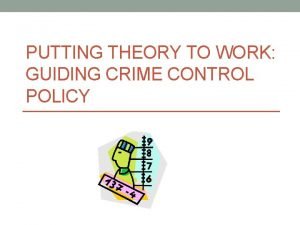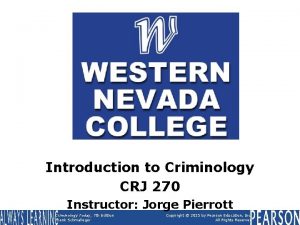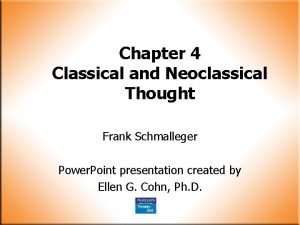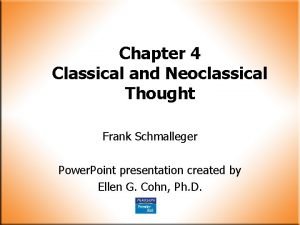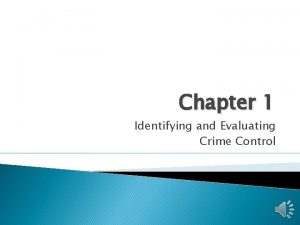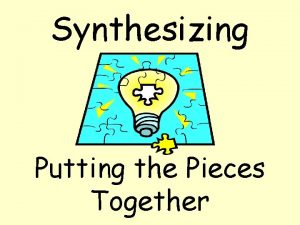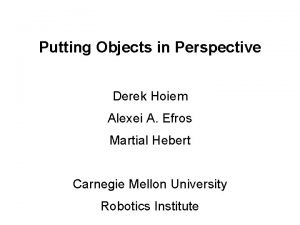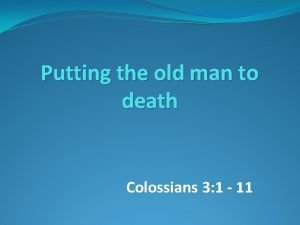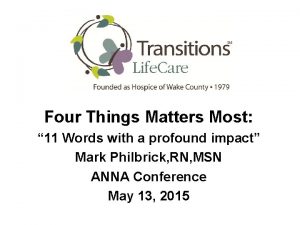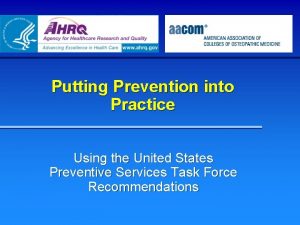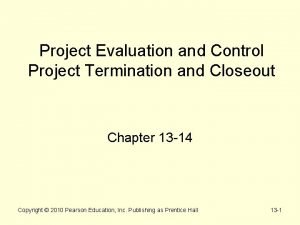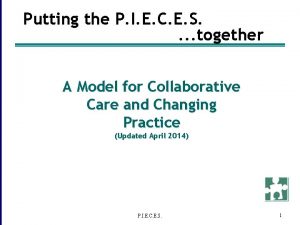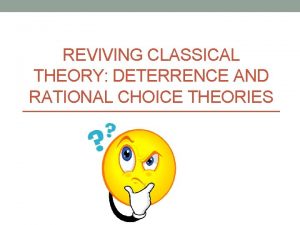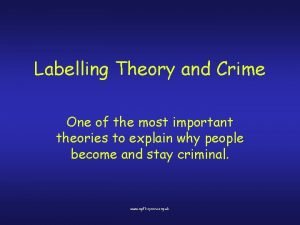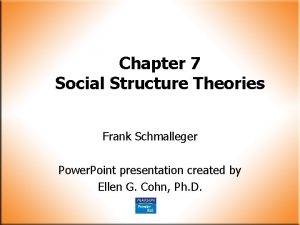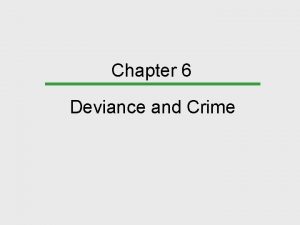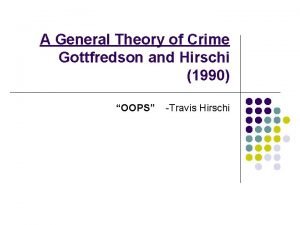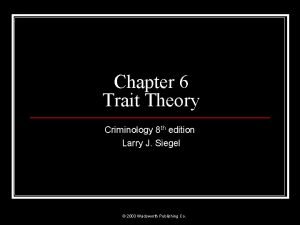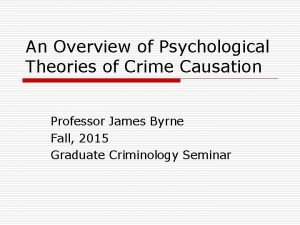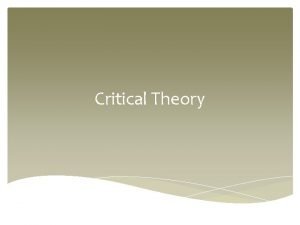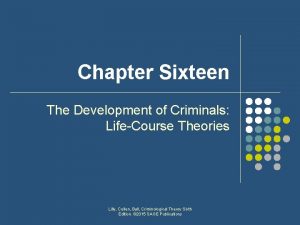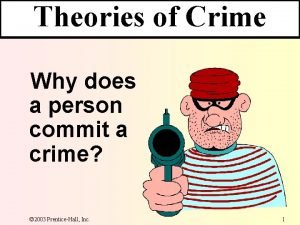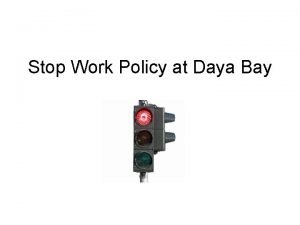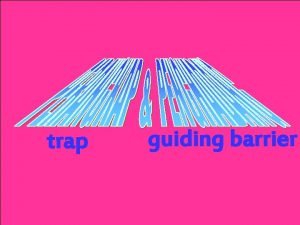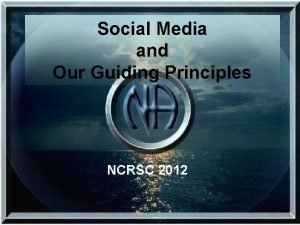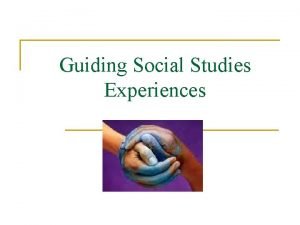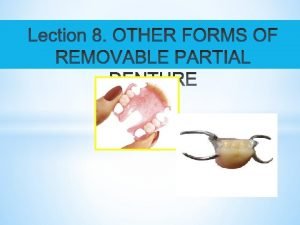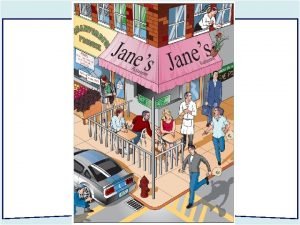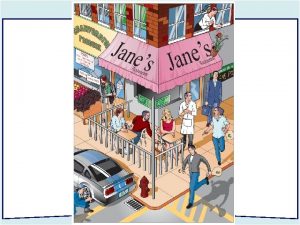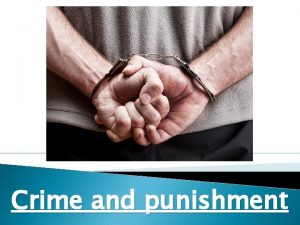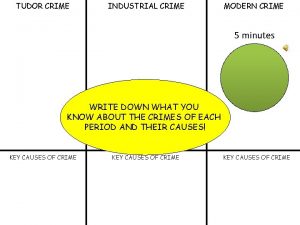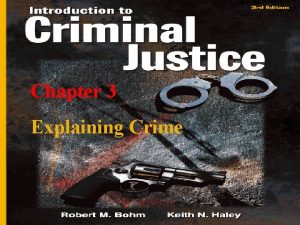PUTTING THEORY TO WORK GUIDING CRIME CONTROL POLICY












































































- Slides: 76

PUTTING THEORY TO WORK: GUIDING CRIME CONTROL POLICY

Crime Control Policy • Many criminologists developed theories in the hope that they would allow us to better control crime • Beccaria work’s fundamentally altered Western legal systems and inspired our current efforts to “get tough” on crime • Braithwaite’s restorative justice movement also has had an impact • Chesney-Lind and the other feminist criminologists alerted the criminal justice system to take into account women’s issues • Cornish and Clarke’s work on situational crime prevention has changed how we try to prevent crime • Wilson and Kelling’s work on broken windows theory changed nature of policing the

Crime Control Policy • Crime control policy is not always drawn from theory • A host of factors influence our response to crime: • Popular perceptions of what works • Views of what is just/appropriate • Political considerations • Lobbying efforts of various groups • Cost considerations • These considerations sometimes lead policy makers to employ crime control initiatives that are ineffective or counterproductive • Examples: Scared Straight, boot camps

Crime Control Policy • Since the 1970 s, efforts to control crime in the U. S. have been focused on increasing the certainty and severity of punishment • The most notable consequence of this get-tough movement was the massive increase in the rate of imprisonment • The U. S. now has the highest rate of imprisonment in the world • This movement has drawn upon classical and deterrence theories

Getting Tough on Crime • Rehabilitation was the guiding philosophy of the criminal justice system from the 1800 s to the 1970 s • Differs from prevention • Prevention tries to stop crime from happening in the first place; however, many of the same programs are used for both prevention and rehabilitation (e. g. , job training) • The War on Poverty was initiated to reduce crime by increasing opportunities for people to achieve monetary success through legal channels • Provide educational assistance and job training • Rooted in strain theory

Getting Tough on Crime In the 1970 s, the crime control strategies of rehabilitation and prevention came under heavy attack • • This was due to: 1. Rising crime rates in the 1960 s leading many to question the effectiveness of rehabilitation and prevention 2. Many studies claimed rehabilitation was ineffective (Martinson’s research) 3. The political climate of the country became more conservative l Politicians argued crime was not rooted in poverty and racism l Rather, criminals were responsible for their behavior and punishment was the best way to reduce crime

Getting Tough on Crime • Those that argued crime was a matter of choice also argued the best way to control it was through punishment • Others argued offenders choose crime because of their moral poverty • The poverty of being without loving, capable, responsible parents and adults who teach you right from wrong, to feel joy at others’ joy, pain at others’ pain, satisfaction when you do right, and remorse when you do wrong

Getting Tough on Crime • Moral poverty is said to produce super-predators • Vicious, remorseless, uncaring, and radically impulsive individuals who readily succumb to the temptation of crime • Moral poverty is rooted in the decline in moral standards in the U. S. and the associated increase in such things as single -parent families • Need a re-imposition of moral standards including a full- scale, concentrated, intense effort at combating drugs and crime

Getting Tough on Crime • This conservative shift was partly a reaction to the civil rights, antiwar, and other political movements of the 1950 s and 1960 s • Many felt threatened by the changes occurring in American society and were attracted to those who promised to crack down on crime and other lawlessness • Politicians were eager to exploit the fears of these people • This argument is compatible with critical criminology

Getting Tough on Crime • Conservative criminologists and policy makers argued that increased punishment would reduce crime for several reasons • First, they drew from the classical school of criminology • View crime as a deliberate choice based on the belief that crime really does pay • Increasing the severity and certainty of punishment would deter offenders from engaging in more crime and deter potential offenders from engaging in crime • Makes the costs outweigh the benefits of the crime • Also expected increasing the number of people imprisoned and the length of their confinement would reduce crime through what is known as the incapacitation effect • Refers to the fact that imprisoned offenders cannot commit crimes in the larger community • Claimed not possible to rehabilitate, so must lock these people up

Getting Tough on Crime • As a result of the argument that rehabilitation does not work, there was a dramatic shift in crime control policy • Beginning in the 1970 s and through today, rehabilitation and prevention have been deemphasized • Instead, the focus is on increasing the severity and certainty of punishment • Laws passed to impose mandatory prison terms, abolish parole, lengthen prison sentences, and make it easier to try serious juvenile offenders as adults • Intermediate sanctions were developed to reduce the cost of imprisonment but still allow severe sanctions • In between regular probation and prison • Include: intensive supervision probation, home confinement, electronic monitoring, boot camps

Challenging Get-Tough Approaches • There is little evidence that punishing offenders or punishing them more severely reduces their level of subsequent offending • Intermediate sanctions (e. g. , boot camps) are not more effective than less severe sanctions (e. g. , probation) • Trying juveniles as adults is not more effective than trying juveniles as juveniles • Harsher prison conditions are not more effective than less harsh conditions

Challenging Get-Tough Approaches • Studies sometimes find that the administration of punishment increases the likelihood of subsequent offending • Reasons that increasing the severity of punishment does not lead to a decrease in crime: • Specific deterrence assumes people are rational; however, there is good reason to question the rationality of many offenders • Offenders often possess the traits of low constraint and high negative emotionality and act impulsively with little thought • Often commit crime in response to strain or pressure from others

Challenging Get-Tough Approaches • Reasons that increasing the severity of punishment does not lead to a decrease in crime: • Punishment does little to address most causes of crime, including individual traits and environmental factors • Punishment does not reduce strain, minimize social learning, or increase control • Punishment may make many of these causes worse • Labeling theory argument • Makes it more difficult to find jobs, weakens ties to conventional others, and promotes the social learning of crime

Challenging Get-Tough Approaches • Reasons that increasing the severity of punishment does not lead to a decrease in crime: • The criminal justice system does not punish in an effective way • Punishments are most effective when individuals are closely monitored and their rule violations are consistently sanctioned in a meaningful, but not overly harsh, manner • The probability that crimes will result in official sanctions is low, and offenders may feel that they can get away with crime in the future • If caught, often dealt with harshly, which can lead to defiance

Challenging Get-Tough Approaches • Reasons that increasing the severity of punishment does not lead to a decrease in crime: • Increasing the certainty of punishment reduces offending in the general population; however, the reduction is modest in size, and certainty has a smaller effect on crime than the other causes of crime • It is often difficult to increase the certainty of punishment • Most efforts have focused on increasing severity, but this has little effect in deterring offenders

Challenging Get Tough Approaches • Incapacitation was expected to stop a great deal of crime • However, this has not been the case because: • Many offenders commit crimes in groups • When one offender is locked up, another offender may emerge to take that person’s place • Offending declines sharply after adolescence and young adulthood • As more and more offenders are locked up, it is increasingly likely to lock up low-rate offenders • Studies have estimated that a 10 percent increase in the incarceration rate may be associated with a 2 to 4 percent reduction in crime • As the incarceration rate increases, reductions in crime become smaller since lower-rate offenders are being imprisoned

Challenging Get Tough Approaches • Some have argued incarceration has negative consequences • Creates a harsh stigmatic label • Reduces employment prospects • Very expensive • Costs approximately $30, 000 per year to confine an offender • It has been concentrated among poor, minority males who live in impoverished neighborhoods

Clear: Imprisoning Communities • Todd Clear argues neighborhoods suffer from a host of problems when there are high incarceration rates • In highly impoverished communities, as many as one-fifth of all men are incarcerated • Leads to more single-parent families, reduces parental supervision, and removes parental role models • Creates economic problems because there are fewer employed residents, people with prison records have a hard time finding work, and the money spent on prisons means there is less spent on schools and jobs • Reduces respect for the legal system and political participation because many are unable to vote with their criminal records • All the above effects reduce the level of control in an area

Clear: Imprisoning Communities • The concentration of imprisonment of young men, especially black men, is now a bedrock experience • Almost a right-of-passage experience • People caught up in the criminal justice system stay there longer, are subjected to more controls, and suffer a greater chance of failure than ever before in history

Clear: Imprisoning Communities Four central points • 1. The growth in the U. S. prison system, sustained for over 30 years, has had a small effect on crime 2. The growth in imprisonment has been concentrated among poor, minority males who live in impoverished communities 3. Concentrated incarceration in those impoverished communities has broken families, weakened the social control capacity of parents, eroded economic strength, soured attitudes toward society, and distorted politics as well as increasing rather than decreasing crime 4. Any attempt to overcome the problems of crime will have to encompass a combination of sentencing reforms and philosophical realignment

Clear: Imprisoning Communities • Incarceration and crime • As a general rule, Americans believe sending people to prison prevents crime • However, the scientific evidence on this relationship is mixed • Incarceration may not decrease crime because: • The person incarcerated is replaced on the street • Almost all who are imprisoned are eventually released • Labeling effects of those who go to prison • There has been a discontinuity between imprisonment rates and crime rates

Clear: Imprisoning Communities • Black men have been imprisoned at higher rates than any other group, especially black high school dropouts • The main reason for this different incarceration rate for black males is drug laws • Although white high school seniors report more drug use than black high school seniors, blacks are more likely than whites to be arrested for drug crimes • Mandatory prison sentences for drug crimes contributed to the discrepancy of whites and blacks in prison • When poor, urban black men living in neighborhoods plagued with poverty go to prison, they join many of their neighbors • Going to prison becomes standard in that neighborhood and it is seen as a rite of passage

Clear: Imprisoning Communities • The cycling of young men through prison in these neighborhoods becomes the dynamic of the neighborhood such that a family is rarely without a man (e. g. , son, father, uncle, cousin) currently in prison or having done prison time in the past • Effects of going to prison on the individual include: • Earning less money during their lifetimes • Making it harder to stay employed • Making the person less likely to marry • Having more psychological or medical problems

Clear: Imprisoning Communities • Since almost every family has a person who is or has done time in prison, everyone is impacted by the prison experience • Having a family member in prison increases the chance of another member doing the same • Neighborhoods with many men in prison have low social capital, keeping both the families and neighborhoods impoverished • Leads to diminished levels of informal social control in the neighborhood

Clear: Imprisoning Communities The consequences of imprisonment to the community are embedded in three important legitimate systems of neighborhood order: • 1. Family 2. Economic 3. Political

Clear: Imprisoning Communities • Family • Communities with high rates of incarceration experience higher rates of family disruption, single-parent families, and births to young, single adults • Parenting is interrupted, roles models are removed, families have to move and change school districts, mothers go on welfare, children receive less supervision, and incarceration experiences are models for children • This contributes to a gradual reduction in social capital in the community

Clear: Imprisoning Communities • Economic systems • High rates of incarceration lead to a surplus of men who have depleted their labor-market prospects in places where labor markets are weak to begin with • Leaves a gap in employable residents • Governmental funding in these areas is focused on penal institutions rather than improving the area

Clear: Imprisoning Communities • Political systems • The overwhelming presence of the criminal justice system in these communities defines the meaning of the state in these areas • The state is seen as a coercive agent of social control rather than a fair agent of justice, which leads people to be less likely to conform to the law • Many claim racism and can validate these accusations • Are less likely to participate in the political process because they are jaded or cannot vote due to their criminal record

Clear: Imprisoning Communities • Presents the coercive mobility hypothesis • Contends that high rates of incarceration concentrated in poor communities will destabilize social networks in those communities, thereby undermining informal social control and leading to more crime • Incarceration suppresses crime through incapacitation and deterrence, though the effects are small • As levels of incarceration increase in impoverished communities, there is a negative effect on the communities’ economic structure, family stability, parental capacity, and prosocial beliefs • These effects outweigh the deterrence and incapacitation effects • Thus, after a certain point, high incarceration rates in an impoverished community increase crime

Clear: Imprisoning Communities Policy implications • • Any solution begins with a recognition of two threshold points: 1. Programmatic tinkering has not reduced the prison population to date 2. To overcome mass incarceration requires that we incarcerate fewer people

Clear: Imprisoning Communities • 5 Two variables fully determine the number of prisoners in any prison system: The number of people who go in 1. • How long they stay 2. • Eliminate mandatory sentencing, especially for drug crimes • Decrease the amount of time offenders are sentenced • The length of stay does not lead to an increased chance of failure The best way to influence the prison population on a major scale is to change either or both of these

Clear: Imprisoning Communities To reduce crime, implement community justice • • The justice system should contribute to the quality of life in communities—to help make places where people work, live, and raise their families good places • Three core elements: 1. Emphasis on restoration 2. Emphasis on maintaining those who are convicted of crime within their communities 3. Purely punitive sanctions are deemphasized in favor of ameliorative sanctions such as community service

Clear: Imprisoning Communities • Community justice strategies could thrive under reduced imprisonment • These strategies have three elements: 1. Focus on high-incarceration places 2. Place attention on the norms and values of those places Restore informal social control mechanisms (e. g. , strengthening families and neighborhood groups, improving the effectiveness of schools, and increasing the vibrancy of the private sector’s presence) • Attempt to improve schools, jobs, and housing 3. Strengthen social support provided by informal social controls • • Try to get more people to obtain a high school diploma, become and remain employed, and increase the quality of housing in the area

Clear: Imprisoning Communities The money needed to do these community justice programs is available • • It is just tied up in the inefficiencies of prison and therefore is unavailable for other programs • If these funds were shifted, two goals would be accomplished: 1. The community development programs receive the resources they need to strengthen poor communities 2. Money spent in the community prevents the collateral damage that otherwise comes from locking up so many residents

Clear: Imprisoning Communities • Research examining Clear’s arguments have been mixed • Incarceration has been shown to have both positive and negative effects • Thus, the consequences of incarceration are varied • Argues that there should be a reduction in incarceration, an increase in community justice programs, and an increase in social supports

More Effective Sanctioning • Some have responded to the criticisms of get-tough approaches by exploring how to make sanctions more effective • Much attention focused on increasing certainty • Suggested strategies should target high-crime areas (e. g. , hot -spot policing) • Hot spots areas with much crime • Research has suggested that crime is likely to occur on certain days and times of the day at certain addresses • Increasing patrols at these hot spots results in a moderate reduction in crime both in and around the hot spots with little evidence of displacement

More Effective Sanctioning • Some have cracked down on individuals at high risk for engaging in certain crimes • Done in Boston with youth gangs • Identified the youth gang members and delivered a clear message to the members that they will have intensive police scrutiny if they continue the violence • Resulted in a reduction in youth homicide

More Effective Sanctioning • Restorative justice approaches aim to sanction offenders more effectively • Inspired by Braithwaite • Promotes reintegrative shaming • Offenders are held accountable for their crimes and through a conference that includes the offender(s), victim(s), and community representatives, where the offenders are made to understand the harm they have caused • Undermines beliefs justifying or excusing the crime • Develops a plan to repair the harm (e. g. , apology, community service) • After the harm is repaired, the offender is forgiven and steps are taken to preserve or strengthen the offenders’ bonds with conventional others • Research shows this approach is effective

More Effective Sanctioning • Other researchers focus on rational choice and routine activities theory • Develop strategies for increasing the costs and/or reducing the benefits of crime • Argue it is difficult to change offenders’ dispositions for crime, but it is easier to alter the characteristics of situations • Make crime more difficult, more risky, rewarding, and less easily excused less

More Effective Sanctioning • Situational crime prevention may increase several costs in addition to the likelihood and severity of official sanction, such as informal sanctions and the moral costs of crime • Situational crime prevention also reduces benefits of crime

Cullen, Eck, and Lowenkamp: “Environmental Corrections” • Cullen, Eck, and Lowenkamp stress the importance of probation and parole officers taking steps to reduce supervisees’ criminogenic propensity and opportunity • Offender supervision often fails because: Officers embrace specific deterrence – offenders will obey the law if watched closely 1. In the 1980 s punishment-oriented intensive supervision programs (ISPs) were trumpeted • • Found ineffective because officers lack resources and ability to watch offenders so closely • Also does not address underlying propensity to offend • Uses uncertain and distant threats • Does not do much to change the opportunities that motivate offenders

Cullen, Eck, and Lowenkamp: “Environmental Corrections” • Offender supervision often fails because: Ignores insights of environmental criminology 2. • Two events needed for a criminal event: 1) a motivated offenders (propensity) and 2) an opportunity for crime • Environmental corrections would have probation and parole officers seek to use rehabilitation to reduce propensity and other strategies to reduce access to criminal opportunities • Traditionally given a standard list of conditions which are typically not individualized for offenders • Environmental corrections would involve creating and using assessment instruments measuring opportunities and seeing how offender handlers and place managers can assist in blocking offenders from criminal influences

Cullen, Eck, and Lowenkamp: “Environmental Corrections” • What works with propensity • Rehabilitation can be effective when following the principles of effective intervention • Using cognitive behavioral intervention with multimodal programs, target known predictors of recidivism, focus on higher-risk offenders, apply sufficient dosage of treatment, and provide appropriate aftercare

Cullen, Eck, and Lowenkamp: “Environmental Corrections” • Core proposition of environmental corrections is that the effectiveness of probation and parole supervision will be increased to the extent that officers systematically work with offenders, family and community members, and the police to reduce the extent to which offenders are tempted by and come into contact with opportunities for crime

Cullen, Eck, and Lowenkamp: “Environmental Corrections” • Probation and parole officers should be problem solvers • Reconceptualize their supervision function as not only watching and busting offenders but also problem solving • Key problem to solve is to reduce offenders’ access to opportunities

Cullen, Eck, and Lowenkamp: “Environmental Corrections” • Instruments to assess offenders’ potential criminal opportunities—opportunity assessment • Insights gained from mapping in detail locations where past offending took place, interviewing offenders asking about the sequence of activities that led them to search for crime, and map out routine activities of offenders

Cullen, Eck, and Lowenkamp: “Environmental Corrections” • Informed by the opportunity assessment, officers should focus on three tasks: 1. With individual supervisees, try to disrupt the routine activities that increase crime opportunities (e. g. , specific conditions such as prohibiting contact with specific people), traveling on certain streets, and access to certain places 2. Develop daily activity calendars scheduling prosocial activities 3. Become handlers of offenders, not just enforcers of supervision • Build informal social control, use positive reinforcements, building bonds with offenders, challenge excuses

Cullen, Eck, and Lowenkamp: “Environmental Corrections” • Officers should also enlist the help of the offender’s family, prosocial friends, and community members • All potential handlers for offender • Have a problem-solving conference • Jointly identify problematic routines and places • Supply positive reinforcement if offenders fulfill behavioral contracts

Cullen, Eck, and Lowenkamp: “Environmental Corrections” • Officers should develop relationships with place managers in the community • Could be used to contact officers when offenders enter prohibited locations • Boston’s Operation Night Light • LEIN

Cullen, Eck, and Lowenkamp: “Environmental Corrections” • In practical terms, environmental corrections is most likely cost effective with high-risk offenders • Evaluation research is needed

Placing More Emphasis on Rehabilitation and Prevention • There have been several major analyses of the effectiveness of rehabilitation and prevention programs, with many being meta-analyses • Well-designed and implemented programs can reduce rates of crime 50 percent or more • Well-designed programs address the known causes of crime (e. g. , strain, low self-control), are intensive (lasting several months or longer), focus on high-risk offenders, and employ a range of techniques to reduce offending (e. g. , direct instruction, demonstrations, role playing with feedback)

Farrington and Welsh: Saving Children from a Life of Crime • Contend the most effective programs focus on individual traits, family, school, peer groups, and community factors • The major causes of crime include impulsiveness, low self- control, poor parental supervision, and association with delinquent peers, so target these to reduce crime • Argue that it is best to address these causes early in life • Early intervention is more effective because children are more receptive than adults to interventions, and they prevent individuals from embarking on a pathway that may eventually lead to long-term, serious offending

Farrington and Welsh: Saving Children from a Life of Crime • Focus mainly on prevention rather than rehabilitation because “prevention is better than a cure” • Identify and tackle key risk factors before they originate or escalate • Research has provided much information about early risk factors for delinquency and later criminal offending • Early risk factors most strongly associated with delinquency and later criminal offending are found at the individual, family, and environmental levels

Farrington and Welsh: Saving Children from a Life of Crime • Individual risk factors include: low intelligence and attainment, personality and temperament, empathy, and impulsiveness • Family risk factors include: criminal and antisocial parents, large family size, poor parental supervision, parental conflict, and disrupted families • Environmental risk factors include: low socioeconomic status, associating with delinquent peers, attending high-delinquency-rate schools, and living in deprived areas

Farrington and Welsh: Saving Children from a Life of Crime • Early intervention has been found to be extremely effective • At the individual level, preschool intellectual enrichment and child skills training programs are effective in preventing delinquency and later offending • At the family level, parent education plus daycare services and parent management training programs are particularly effective • Among environmental approaches, school-based initiatives and after-school and community-based mentoring are effective

Farrington and Welsh: Saving Children from a Life of Crime Risk-focused prevention • • Crime prevention strategies are divided into three categories: 1. Primary l Measures targeted on the whole community to prevent the onset of delinquency 2. Secondary l Focuses on intervening with children and youth who are at risk of becoming delinquent because of the presence of one or more risk factors 3. Tertiary l Measures targeted on offenders

Farrington and Welsh: Saving Children from a Life of Crime • There are four major prevention strategies: 1. Developmental prevention or risk-focused prevention • Interventions designed to prevent the development of criminal potential in individuals, especially targeting risk and protective factors Community prevention 2. • Change the social conditions and institutions that influence criminogenic influences in communities Situational prevention 3. • Designed to prevent the occurrence of crime by reducing opportunities for offending and increasing its risk/difficulty Criminal justice prevention 4. • Traditional deterrent, incapacitative, and rehabilitative strategies used by the criminal justice system

Farrington and Welsh: Saving Children from a Life of Crime • Individual prevention • Target factors found within the individual and directed only at the individual • Wide support for these programs • Implemented early in life when children are most impressionable • A primary emphasis is on improving school readiness, providing families in need with various other services, and reaching about half of all impoverished children • Example: Head Start

Farrington and Welsh: Saving Children from a Life of Crime Individual prevention • • Two main types of individual-based programs have been found effective: 1. Preschool intellectual enrichment l Target on the risk factors of low intelligence and attainment l Provide economically disadvantaged children with cognitively stimulating and enriching experiences that their parents are unlikely to provide at home l Improved cognitive skills, school readiness, and social and emotional development are the main goals l Key features of these programs include: a. Developmentally appropriate learning curricula b. A wide array of cognitive-based enriching activities c. Activities for parents so they can support the school experience at home

Farrington and Welsh: Saving Children from a Life of Crime Individual prevention • • Two main types of individual-based programs have been found effective: 2. Child social skills training l Target the risk factors of impulsivity, low empathy, and selfcenteredness l Directly teach children social, emotional, and cognitive competence by addressing social skills, effective problem-solving, anger management, and emotion language l Often combines child skills training and parent training l Includes coaching, peer modeling, role playing, and reinforcement l Found to be effective 3 years after treatment

Farrington and Welsh: Saving Children from a Life of Crime • Family prevention • Target poor child rearing, poor supervision, and inconsistent or harsh discipline • Include parent management training, functional family therapy, multisystemic family therapy, and family prevention programs • Attempt to change the social contingencies in the family environment so children are rewarded for appropriate behavior and punished for inappropriate behavior • Cost effective • Also effective for adjudicated juvenile and adult populations

Farrington and Welsh: Saving Children from a Life of Crime Family prevention • • Two main types of family-based programs have been found effective: 1. Parent education a. Home visiting programs l Home visits with parents delivering general parent education l Main goals center around educating parents to improve the life chances of children from a very young age, often beginning at birth, preventing preterm or low-weight births, promoting healthy child development or school readiness, and preventing child abuse and neglect l Also attempt to improve parent well-being and link parents with community services

Farrington and Welsh: Saving Children from a Life of Crime Family prevention • • Two main types of family-based programs have been found effective: 1. Parent education b. Parent education plus day care l Day-care programs are distinguished from preschool programs in that day-care programs are not focused on intellectual enrichment but rather serve as a form of childcare that allow parents to return to work l Day care provides children with social interaction with other children and stimulation of their cognitive, sensory, and motor control skills

Farrington and Welsh: Saving Children from a Life of Crime Family prevention • • Two main types of family-based programs have been found effective: 2. Parent management training l Refers to treatment procedures in which parents are trained to alter their child’s behavior at home l Parents of antisocial children are deficient in their methods of child rearing l l Failed to tell their children how they were expected to behave, failed to monitor their children’s behavior, failed to enforce rules properly, and used more punishments but failed to make it contingent on the child’s behavior Teaches parents to notice what the child is doing, monitor behavior over long periods of time, clearly state rules, make rewards and punishments contingent on behavior, and to negotiate disagreements so conflicts do not escalate

Farrington and Welsh: Saving Children from a Life of Crime Peer, school, and community prevention all target environmental risk factors • Peer-based programs • Two aims: • 1. Reduce the influence of delinquent friends 2. Increase the influence of prosocial friends • • Teach children to resist antisocial peer pressures that encourage delinquent activities Research has shown that programs using peer leaders can reduce smoking, drinking, and drug use

Farrington and Welsh: Saving Children from a Life of Crime School-based programs • • Students who are impulsive, have little commitment to school, are weakly bonded to school, and have weak conventional beliefs are more likely to be delinquent • Four types of school programs have been found to be effective: 1. School and discipline management 2. Classroom or instructional management 3. Reorganization of grades or classes 4. Increasing self-control or social competency using cognitive-behavioral or behavioral instructional methods

Farrington and Welsh: Saving Children from a Life of Crime • School-based programs • School and discipline management • Project PATHE was effective • Included increasing shared decision-making in schools, increasing the competence of teachers, increasing the academic competence of students, and improving the school climate • Increases the students’ sense of belonging and usefulness

Farrington and Welsh: Saving Children from a Life of Crime • School-based programs • Classroom or instructional management • Combine parent training, teacher training, and skills training • Receive special attention at home and school to increase attachment to school and parents • Parents trained to notice and reinforce good behavior • Teachers trained in classroom management (e. g. , provide clear instructions, reward children for good behavior, teach prosocial problem-solving skills) • Also receive training in interpersonal cognitive problem-solving

Farrington and Welsh: Saving Children from a Life of Crime • School-based programs • Reorganization of grades or classes • STATUS program • Used school within school scheduling where high-risk students were brought together for a 2 -hour period to receive an integrated social studies and English program with a law-related education curriculum that emphasized maximum participation

Farrington and Welsh: Saving Children from a Life of Crime • School-based programs • Increasing self-control or social competency using cognitive- behavioral or behavioral instructional methods • Teaches students factual information, increases their awareness of social influences to engage in misbehavior, expands their repertoires for recognizing and appropriately responding to risky situations, increases their appreciation for diversity, and improves their moral character • RIPP program • 18 -session violence prevention curriculum, divided into seven topics: building trust, respect for individual differences, nature of violence and risk factors, anger management, personal values, precipitants and consequences of fighting, and nonviolent alternatives to fighting

Farrington and Welsh: Saving Children from a Life of Crime Community-based programs • • Often a combination of developmental prevention, with its focus on reducing the development or influence of early risk factors, and situational prevention, with its focus on reducing opportunities for crime • Two main types of programs: 1. After-school programs 2. Community-based mentoring

Farrington and Welsh: Saving Children from a Life of Crime • Community-based programs • After-school programs • Based on the belief that providing prosocial opportunities after school can reduce involvement in delinquent behavior • Target alienation and association with delinquent peers • Include recreation-based programs, drop-in clubs, dance groups, and tutoring services • Boys and Girls Club provides after-school programs in six main areas: cultural enrichment, health and physical education, social reaction, personal and educational development, citizenship and leadership development, and environmental education

Farrington and Welsh: Saving Children from a Life of Crime • Community-based programs • Community-based mentoring • Involves nonprofessional adult volunteers spending time with young people at risk for delinquency, dropping out of school, school failure, and other social problems • Mentors behave in a supportive, nonjudgmental manner while acting as role models and forming strong bonds • Big Brothers Big Sisters provides youth with an adult friend where the mentor can support and aid the youth

Farrington and Welsh: Saving Children from a Life of Crime • Present a comprehensive national prevention strategy • Focus should be on intervening early to save children from a life of crime • Grounded in the leading scientific evidence on the causes of offending and what works to prevent delinquency and later offending • Needs a clear vision of intent that early prevention of delinquency saves lives

Summary • Much research has been done on the causes of crime • This research can and is being used to direct crime- control policy • From the 1800 s until the 1970 s, rehabilitation was the main focus of the criminal justice system • Since the 1970 s, the U. S. has been involved in a get-tough movement • However, this movement is now being questioned and replaced with situational crime prevention focused on crime opportunities and prevention/rehabilitation initiatives
 Commercial crime coverage form
Commercial crime coverage form Crime control policies
Crime control policies Crime control policies
Crime control policies Crime control policies
Crime control policies Chapter 7 deviance crime and social control
Chapter 7 deviance crime and social control Classical and neoclassical theory criminology
Classical and neoclassical theory criminology Crime control policies
Crime control policies Crime control policies
Crime control policies Crime control policies
Crime control policies Putting-out system
Putting-out system What is nasreen putting chocolate on
What is nasreen putting chocolate on Long term impacts of the industrial revolution
Long term impacts of the industrial revolution Putting-out system
Putting-out system Puts the pieces together if in use maybe
Puts the pieces together if in use maybe Rate fences services marketing
Rate fences services marketing Putting objects in perspective
Putting objects in perspective Putting evidence into practice
Putting evidence into practice The order of putting on ppe
The order of putting on ppe Putting it all together motion answer key
Putting it all together motion answer key Ordering fractions
Ordering fractions Putting people first 2007
Putting people first 2007 Putting-out system
Putting-out system Polynomial names by degree and number of terms
Polynomial names by degree and number of terms Putting the enterprise into the enterprise system
Putting the enterprise into the enterprise system Letters put together
Letters put together A 3-d work of art created by shaping or combining materials
A 3-d work of art created by shaping or combining materials Putting zone
Putting zone Put to death the old man
Put to death the old man Enterprise
Enterprise Putting stance width
Putting stance width Package mypackage class first class body
Package mypackage class first class body Putting a speech together in a particular way
Putting a speech together in a particular way Practice putting it all together part 1 fill in the blank
Practice putting it all together part 1 fill in the blank Putting it into practice
Putting it into practice Putting prevention into practice
Putting prevention into practice Putting on the new man
Putting on the new man Putting two words together
Putting two words together Introduction bridge examples
Introduction bridge examples Putting it all together
Putting it all together Putting it all to bed during project closeout includes
Putting it all to bed during project closeout includes Coherent curriculum
Coherent curriculum Putting the pieces together case study answer key
Putting the pieces together case study answer key Putting things together is called
Putting things together is called Sociological perspective of crime
Sociological perspective of crime Rational choice theory
Rational choice theory Labelling theory crime
Labelling theory crime Social structure theory crime
Social structure theory crime Symbolic interactionism vs functionalism
Symbolic interactionism vs functionalism Gottfredson and hirschi (1990)
Gottfredson and hirschi (1990) Thornberry's interactional theory
Thornberry's interactional theory Conflict theory definition criminology
Conflict theory definition criminology Age graded theory
Age graded theory Biological trait theory criminology
Biological trait theory criminology Neoclassical theory of crime
Neoclassical theory of crime Psychological theories of crime
Psychological theories of crime Conflict critical theory
Conflict critical theory Life course theory crime
Life course theory crime Classical theory of crime
Classical theory of crime Define policy practice
Define policy practice Stop work policy
Stop work policy Dignity at work policy
Dignity at work policy Inflation
Inflation Fiscal policy to control inflation
Fiscal policy to control inflation Credit control measure of rbi
Credit control measure of rbi Guiding barrier
Guiding barrier Rest seat preparation
Rest seat preparation Sendai framework guiding principles
Sendai framework guiding principles Ncrsc
Ncrsc Wmels 5 domains
Wmels 5 domains Laws guiding book publishing in nigeria
Laws guiding book publishing in nigeria Ncf curriculum framework 2005
Ncf curriculum framework 2005 Guiding principles for teaching and learning in mtb-mle pdf
Guiding principles for teaching and learning in mtb-mle pdf Mcpon guiding principles 2021
Mcpon guiding principles 2021 Chapter 20 guiding storytelling experiences
Chapter 20 guiding storytelling experiences Importance of social science
Importance of social science Guiding play
Guiding play Guide planes rpd
Guide planes rpd

